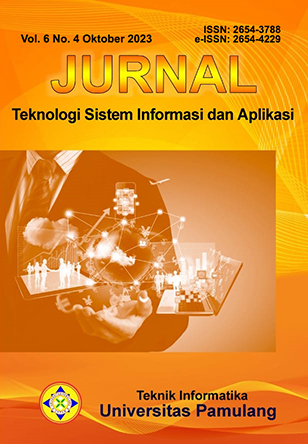Digitalisasi Informasi Manajemen Aset sebagai Sarana Penunjang Operasional Kampus Menggunakan Metode Relational Unified Process
Kata Kunci:
Asset Management, Politeknik Baubau, UPT Aset, Relational Unified ProcessAbstrak
Campus asset management is the processing of operational supporting infrastructure on campus. So far, the asset management system at the Baubau Polytechnic Campus still uses the conventional method, namely by recording through albums and control cards attached to the walls of each room. This method is prone to loss of assets because it is not controlled. For this reason, software for digitizing asset management information is needed using the Relational Unified Process (RUP) system development method. The approach of this method is iterative and use case driven which focuses on solving asset management problems. This system works to control in real time the process of borrowing or transferring assets. this system is very helpful for the Baubau Polytechnic Campus in managing assets, especially on the problem of losing assets. This system also provides information about the physical condition of assets in each room so that it can assist the Asset Technical Implementation Unit (UPT) to transfer assets so that campus operations can run optimally.
Referensi
Alfianto, F., Wulandari, S. H. E., & Santoso, R. (2016). Rancang Bangun Aplikasi Pengelolaan Aset Pada PT. Bina Megah Indowood. Jsika, 6(3), 1–6.
Baijuri, A., Rizqi, D. I., & Ghofur, A. (2023). JUSTIFY : Jurnal Sistem Informasi Ibrahimy Pengembangan Sistem Informasi Inventaris Barang Pada Sekolah Sma Ibrahimy 2 Berbasis Web. 1(2), 145–152.
Cholifah, W. N., Yulianingsih, Y., & Sagita, S. M. (2018). Pengujian Black Box Testing pada Aplikasi Action & Strategy Berbasis Android dengan Teknologi Phonegap. STRING (Satuan Tulisan Riset Dan Inovasi Teknologi), 3(2), 206. https://doi.org/10.30998/string.v3i2.3048
Dewi, S., Jannah, L. M., & Jumaryadi, Y. (2018). Analisis dan Perancangan Sistem Informasi Manajemen Aset Tetap pada PT. Metis Teknologi Corporindo. Jurnal Sistem Informasi, Teknologi Informatika Dan Komputer, 9(September), 81–91.
Dwi Putri, R., & Andryani, R. (2022). Rancang Bangun Sistem Informasi Inventaris Barang Pada SMP Negeri 01 Runjung Agung Berbasis Website. JIPI (Jurnal Ilmiah Penelitian Dan Pembelajaran Informatika), 07(04), 1168–1175. https://jurnal.stkippgritulungagung.ac.id/index.php/jipi/article/view/3201
Effendy, M. Y., Nurninawati, E., & Ari Setiyawan, A. (2022). Design And Build A Web-Based Asset Management Information System at Pt Thamrin Telekomunikasi Network. Aptisi Transactions on Technopreneurship (ATT), 4(1), 48–58. https://doi.org/10.34306/att.v4i1.233
Fadilah Ghandy, Q., Syahidin, Y., Gunawan, E., Yuniarty, N., Informasi Kesehatan, M., Piksi Ganesha, P., Gatot Subroto No, J., Bandung, K., & Barat, J. (2023). Jurnal Teknologi Sistem Informasi dan Aplikasi Implementasi Metode RAD pada Pelaporan Morbiditas Elektronik Guna Menunjang Tata Kelola Rekam Medis. 6(2), 102–109. https://doi.org/10.32493/jtsi.v6i2.29687
Hakimin, K., Jaroji, & Subandri, M. A. (2021). Penerapan Metode Rational Unified Process ( Rup ) Pada Pembuatan Aplikasi Public Speaking. Seminar Nasional Industri Dan Teknologi (SNIT), 250–259. https://snit-polbeng.org/eprosiding/index.php/snit/article/download/225/178
Hasan, W. A. (2019). Sistem Pengelolaan Aset Tetap Pada Sekretariat Daerah Kabupaten Buton. Jurnal Ilmiah Akuntansi Manajemen, 2(1), 27–38. https://doi.org/10.35326/jiam.v2i1.252
Ridwan, M., Muhammad, M., & Ramadhani, S. (2018). Rancangan Sistem Informasi Manajemen Aset di PT. Sentral Tukang Indonesia. Jurnal CoreIT: Jurnal Hasil Penelitian Ilmu Komputer Dan Teknologi Informasi, 3(2), 47. https://doi.org/10.24014/coreit.v3i2.4415
Saputra, R. O., Syahidin, Y., Sari, I., & Sukmawijaya, J. (2023). Rancang Bangun Sistem Informasi Surat Keterangan Lahir Menggunakan Metode Waterfall di Rumah Sakit X. 6(2), 125–134. https://doi.org/10.32493/jtsi.v6i2.29698
Sarimuddin, S., & Bantun, S. (2021). Sistem Absensi Pegawai Berbasis RFID ( STUDI KASUS : Kantor BKP-SDM Kabupaten Bombana ). January 2022. https://doi.org/10.5281/zenodo.5790847
Suswara, M., & Kurniawan, I. (2022). Perancangan Sistem Pengelolaan Inventaris Barang Sarana dan Prasarana di SMKN 7 Bekasi. Jurnal Riset Dan Aplikasi Mahasiswa Informatika (JRAMI), 3(01), 118–124. https://doi.org/10.30998/jrami.v3i01.2383
Turnip, L., Triayudi, A., & Solihati, I. D. (2020). Web Based Fixed Asset Management Information System Using the Waterfall Method (Case Study: National University). Jurnal Mantik, 4(1), 613–623. https://iocscience.org/ejournal/index.php/mantik
Yogi Isro’ Mukti, M. K. (2019). Sistem Informasi Manajemen Aset Sekolah Tinggi Teknologi Pagaralam Berbasis Web. Indonesian Journal of Business Intelligence (IJUBI), 1(2), 81. https://doi.org/10.21927/ijubi.v1i2.918
Unduhan
Diterbitkan
Cara Mengutip
Terbitan
Bagian
Lisensi
Hak Cipta (c) 2023 Abel Haryanto, La Sudarman, Sarimuddin Sarimuddin

Artikel ini berlisensi Creative Commons Attribution-NonCommercial 4.0 International License.
Authors who publish with this journal agree to the following terms:
- Authors retain copyright and grant the journal right of first publication with the work simultaneously licensed under a Creative Commons Attribution License that allows others to share the work with an acknowledgement of the work's authorship and initial publication in this journal.
- Authors are able to enter into separate, additional contractual arrangements for the non-exclusive distribution of the journal's published version of the work (e.g., post it to an institutional repository or publish it in a book), with an acknowledgement of its initial publication in this journal.
- Authors are permitted and encouraged to post their work online (e.g., in institutional repositories or on their website) prior to and during the submission process, as it can lead to productive exchanges, as well as earlier and greater citation of published work (See The Effect of Open Access).
Jurnal Teknologi Sistem Informasi dan Aplikasi have CC BY-NC or an equivalent license as the optimal license for the publication, distribution, use, and reuse of scholarly work.
In developing strategy and setting priorities, Jurnal Teknologi Sistem Informasi dan Aplikasi recognize that free access is better than priced access, libre access is better than free access, and libre under CC BY-NC or the equivalent is better than libre under more restrictive open licenses. We should achieve what we can when we can. We should not delay achieving free in order to achieve libre, and we should not stop with free when we can achieve libre.
This work is licensed under a Creative Commons Attribution-NonCommercial 4.0 International (CC BY-NC 4.0) License
YOU ARE FREE TO:
- Share - copy and redistribute the material in any medium or format
- Adapt - remix, transform, and build upon the material for any purpose, even commercially.
- The licensor cannot revoke these freedoms as long as you follow the license terms



_2020_-_7(2)_2024_-_Thumbnail.png)












